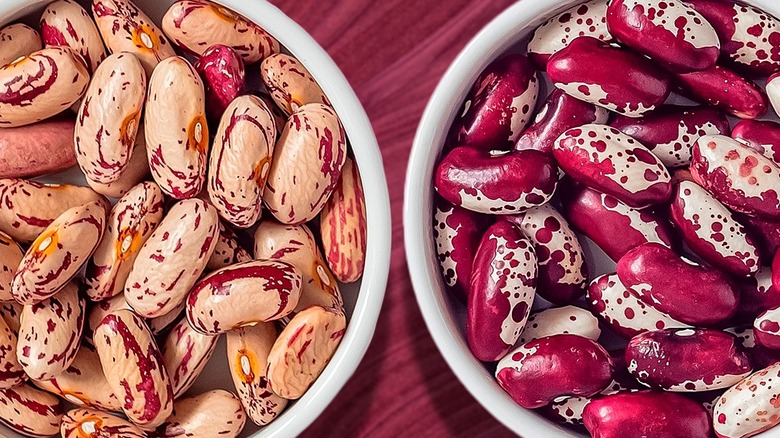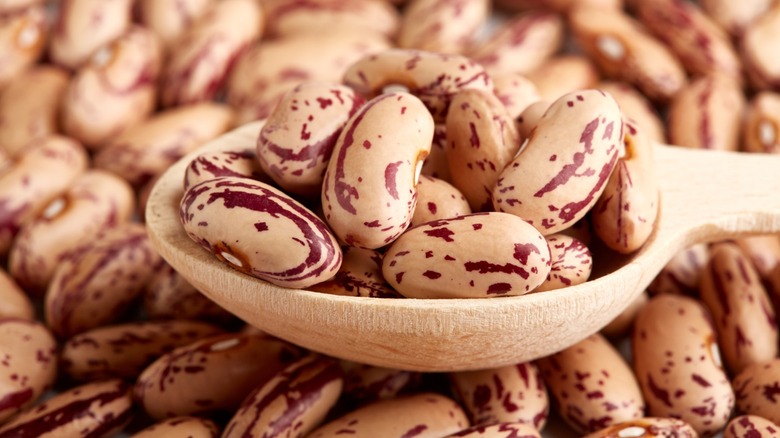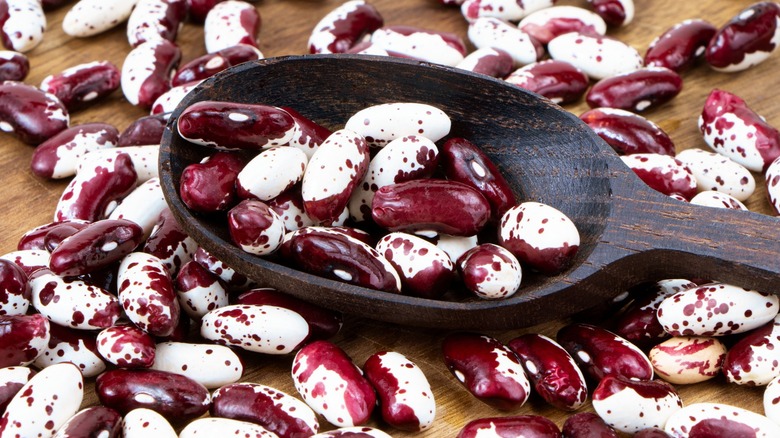Are Pinto And Anasazi Beans Different Or Interchangeable?
Enjoyed in countless ways from refreshing salads to hearty stews, who doesn't love good ol' beans packed with fiber and protein? With 40,000 varieties, you're bound to find one that fits your flavor or recipe preferences — like pinto and Anasazi beans, which are completely different beans yet often mistaken for each other due to their speckled appearance. Both are staples in Southwestern cuisine and can be swapped in many recipes, but their unique flavors and textures make them better suited for certain dishes.
Pinto beans, larger and creamier with a nuttier flavor, tend to break down more easily, which is perfect for creamy soups, refried beans, or dips. On the other hand, Anasazi beans are smaller and firmer, with a subtle sweeter taste. They cook faster and hold their shape better, making them ideal for salads and casseroles.
It's important to note that Anasazi beans carry a cultural controversy that calls for deeper understanding. The term "Anasazi," meaning "ancient enemy" in Navajo, was historically used to label the Ancestral Pueblo people of the American Southwest. Its use reflects cultural misrepresentation, imposing an outsider's perspective that disregards how Pueblo communities honor their ancestors. Although "Anasazi beans" is still used commercially, we will refer to them as "cave beans" — an alternative name reflecting their discovery in caves and ancient cliffside dwellings in Navajo territory — to promote a more culturally sensitive understanding of Indigenous history.
Pinto beans
Originating over 7,000 years ago in the Andes and Mexico, the nutritious pinto bean is one of the most widely consumed varieties in the U.S.,. Named for the Spanish word for "painted," pintos can be identified by their light tan color and reddish-brown streaks. They lose their characteristic patterns when cooked, transforming into soft, creamy, light-brown beans widely used in Mexican and Southwestern cuisine.
Containing 15.5 grams of fiber per 100 grams, cooked pinto beans develop a slightly earthy flavor and a buttery texture, making them especially ideal for recipes that call for a rich, velvety finish in which the beans can break down without needing to hold their shape. For example, pinto beans are perfect for bean dips and refried beans, as their softness and tender skins blend easily into a hearty, smooth texture.
Cooking dried pinto beans is simple. Just time and water are all that's needed — and soaking dried pintos isn't necessary. Simply ensure you add enough water and cook them patiently, or let the slow cooker handle the work for you. The good news is that canned beans can deliver the same smooth goodness as dried beans, offering a convenient option that's just as delicious and not at all an inferior choice, despite the myths surrounding them.
Cave beans
An ancient heirloom variety cultivated by the Ancestral Pueblo people, who began settling in the Four Corners region in the U.S. around 1500 B.C., cave beans are known for their white and maroon speckled pattern, which turns a brownish-pink color after cooking. Their name comes from their discovery in ancient jars found in dry cliff caves in Navajo territory. Evidence suggests the Ancestral Pueblo people may have cooked and stored these beans alongside maize.
With a mild flavor, slightly grainy texture, and subtle sweetness, these smaller beans cook faster than pinto beans and maintain their shape well. Just as nutritious as pinto beans, cave beans boast 14.4 grams of fiber per 100 grams and have fewer calories and less fat. They are also easier to digest and produce fewer gas-causing compounds.
Because they keep their shape, they're excellent for bean salads, casseroles, chili, and other dishes that benefit from a firmer bite and the presentation of plump, whole beans. And cooking cave beans from dried is just as simple as cooking dried pintos. All it takes is a few expert techniques for cooking beans such as using a pressure cooker or a slow cooker — along with enough patience to allow them transform into a bowl of hearty goodness.


